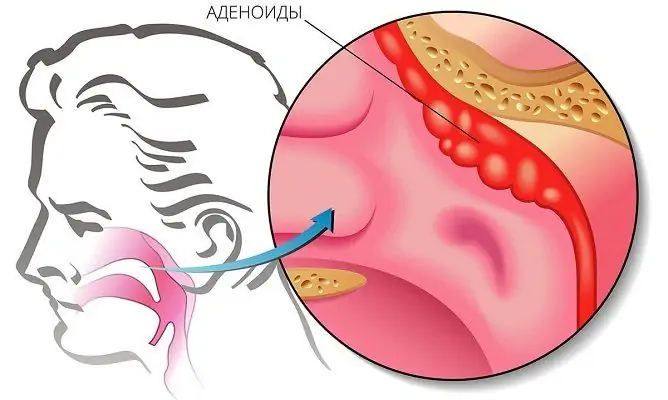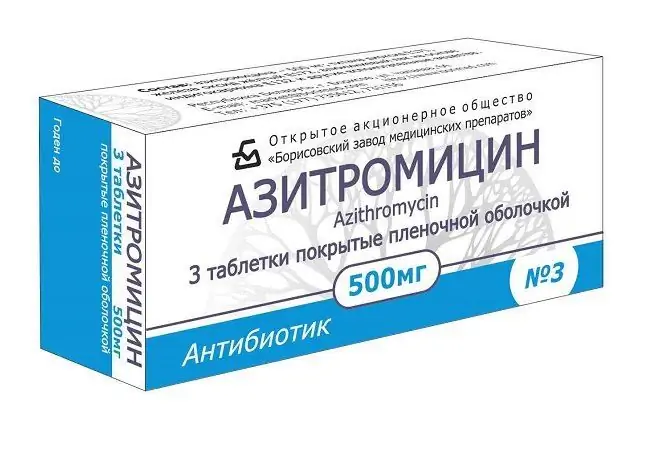- Author Rachel Wainwright [email protected].
- Public 2023-12-15 07:39.
- Last modified 2025-11-02 20:14.
Lacunar angina
The content of the article:
- Causes and risk factors
- Forms of the disease
- Disease stages
- Symptoms of lacunar sore throat
- Features of the course of lacunar angina in children
- Diagnostics
- Treatment of lacunar sore throat
- Possible complications and consequences
- Forecast
- Prevention
Lacunar tonsillitis, or lacunar tonsillitis, is an acute infectious disease that affects the tonsils that make up the lymphatic pharyngeal ring, often palatine. The name indicates a characteristic symptom: in the gaps (depressions) of the hyperemic tonsils, a yellow-white purulent plaque accumulates.
The disease is more susceptible to children and adolescents. Lacunar angina in adults is less common, and after 50 years it is practically not diagnosed. The peak incidence of lacunar angina occurs in the autumn-winter period.

The appearance of a mucopurulent or fibrous-purulent plaque on the tonsils is a characteristic symptom of lacunar tonsillitis
Causes and risk factors
The causative agents of lacunar sore throat are most often streptococci (especially β-hemolytic group A streptococcus), staphylococci and pneumococci, less often - Pseudomonas aeruginosa and adenoviruses; combined infection also occurs. Infection occurs not only through direct contact with a sick person or a carrier of bacteria, but also through common household items.
The development of the infectious process is facilitated by the suppression of the functions of the immune system as a result of hypothermia, unbalanced nutrition and vitamin deficiency, overwork, stress, lack of sleep, etc. The influence of seasonal factors is traced: the incidence of lacunar angina increases in the cold season.

Most often, lacurnar angina occurs under the influence of streptococci, staphylococci and pneumococci
The tonsils of the pharyngeal ring are organs of the immune system, whose task is to neutralize infectious agents entering the body from the upper respiratory tract. The tonsils have a large area due to lacunae - depressions in the lymphoid tissue. This increases the possibility of contact of lymphocytes with bacteria and viruses with their subsequent neutralization. However, with the weakening of the body's defenses, the tonsils do not cope with their task, as a result of which the infectious agents "captured" by them cause an inflammatory process in the lymphoid tissue itself - this is how lacunar angina develops.
In some cases, there is a transition of other forms of angina into the lacunar form, which is facilitated by an external infection or the presence of chronic infectious foci, which often occur with advanced caries, chronic tonsillitis and sinusitis.
Forms of the disease
Lacunar tonsillitis is often combined with a follicular form, accompanied by suppuration of the tonsil follicles and the formation of abscesses in them. In such cases, they speak of follicular-lacunar angina.
Disease stages
During angina, 4 stages are distinguished:
- Incubation period. Lasts 1-2 days.
- Initial stage. The period from the appearance of the first mild signs to a detailed clinical picture. Lasts from several hours to a day.
- The height of the disease, the period of the expanded clinical picture. Duration - 3-7 days.
- Recovery, or convalescence. It takes about a week.
Symptoms of lacunar sore throat
Lacunar angina makes itself felt quite sharply. The disease begins with a sudden increase in body temperature to 38-40 ° C, aches in the muscles (mainly in the calves and in the lumbar region) and joints (including the temporomandibular), a feeling of weakness and pain in the throat, which increases with swallowing and talking.
For the height of lacunar tonsillitis, the following are characteristic:
- sore throat of high intensity (it is difficult for the patient to speak and eat due to pain);
- feeling of a lump in the throat;
- swelling and redness of the tonsils and palatine arches;
- hoarseness and sometimes loss of voice;
- an increase in regional lymph nodes.

Lacunar angina begins with an increase in body temperature to 38-40 ° C
The appearance of a mucopurulent or fibrous-purulent plaque on the tonsils is a characteristic symptom of lacunar tonsillitis, which distinguishes it from other forms of the disease. Sometimes the foci of suppuration merge, covering most of the surface of the tonsils, without leaving, however, beyond their limits. When trying to remove plaque, it is easily separated without subsequent bleeding.
Features of the course of lacunar angina in children
Lacunar angina in children proceeds somewhat differently than in adults. Children, especially small children, tolerate fever worse and may develop convulsions against a background of high fever. With severe inflammatory swelling of the tonsils, the child experiences breathing problems up to attacks of suffocation, which, in combination with convulsions, can be especially dangerous. Some children have severe headaches and abdominal pains, nausea and vomiting. If such symptoms appear, urgent medical advice is needed. Parents should keep in mind that streptococcal infection, which most often causes lacunar sore throat, can cause serious complications, affecting vital organs, including the kidneys and heart muscle. Therefore, self-treatment of lacunar sore throat is unacceptable, the doctor should be engaged in the selection of drugs and treatment regimen.

In children, an increase in temperature with lacunar angina may be accompanied by convulsions
Diagnostics
The diagnosis of lacunar sore throat is made on the basis of anamnesis and a characteristic clinical picture. Since the standard treatment regimens for angina involve the use of antibiotics, a bacteriological study is carried out in order to identify the pathogen and target selection of drugs.
If a viral infection is suspected, they usually resort to PCR (polymerase chain reaction) testing.
Treatment of lacunar sore throat
Hospitalization for the treatment of lacunar angina, as a rule, is not required, but bed rest is necessary. To prevent dehydration, it is recommended to drink plenty of warm drinks.
Since in the vast majority of cases the disease is of a bacterial nature, the main therapy consists in the use of antibacterial drugs of systemic (general) action. As a rule, with lacunar angina, antibiotics of three groups are prescribed: penicillins, macrolides, cephalosporins. The duration of the course is 7-10 days.
With severe swelling of the tonsils and lymph nodes, antihistamines are additionally prescribed. Antipyretic drugs should be used only at temperatures above 38 ° C for 1-3 days.

Since in most cases, lacunar angina is of a bacterial nature, the use of antibiotics is indicated
To remove pus and microbial plaque, gargle 6-8 times a day with antiseptic solutions and decoctions of medicinal herbs that have an antiseptic effect.
During treatment, it is necessary to adhere to a diet that excludes any irritating foods, the food taken should be easily digestible, warm and soft (semi-liquid, puree, slimy dishes are welcome). With lacunar angina, adults should stop drinking alcohol.
Possible complications and consequences
In the absence of proper treatment, lacunar tonsillitis can turn into chronic tonsillitis: in this case, relapses are replaced by remissions, while an infection is constantly present in the body. From constant exposure to microbial toxins, the kidneys, heart and joints are primarily affected; development of atopic and autoimmune conditions is not excluded. In order to exclude the long-term consequences of the disease after a sore throat, it is advisable to do an ECG and pass general urine and blood tests.
With the follicular-lacunar form of angina, left without proper attention, there is a possibility of abscess breakthrough and the development of phlegmonous angina, against which the risk of developing life-threatening conditions - meningitis and generalized sepsis increases.
Forecast
With a timely visit to a doctor and a responsible approach to treatment, lacunar angina is successfully cured and does not give complications.
Prevention
A tendency to sore throats and colds indicates a weakness of the immune system. To strengthen the immune system, it is recommended to do hardening, observe a sparing daily regimen, avoid stress, adhere to the principles of a healthy diet and be more outdoors.

Anna Kozlova Medical journalist About the author
Education: Rostov State Medical University, specialty "General Medicine".
The information is generalized and provided for informational purposes only. At the first sign of illness, see your doctor. Self-medication is hazardous to health!






